PPMP20009: Leading Lean Projects - Dream Home Construction Report
VerifiedAdded on 2022/10/04
|9
|2328
|31
Report
AI Summary
This report details the process of managing the construction of a dream home, focusing on project management and leadership. The student begins by identifying a suitable suburb in Western Australia and outlining the land requirements, budget, and builder selection. The report then addresses potential conflicts with both the partner and the builder, proposing strategies for resolution such as compromise, clear communication, and utilizing the builder's expertise. It emphasizes the importance of quick decision-making and collaboration. The leadership style chosen for the project is democratic leadership, highlighting the need for a collaborative approach, distribution of responsibilities, job satisfaction, and open communication. The report concludes by emphasizing the importance of creating a peaceful atmosphere and encouraging innovative solutions for successful project completion. The report is a valuable resource for students studying project management and leadership.
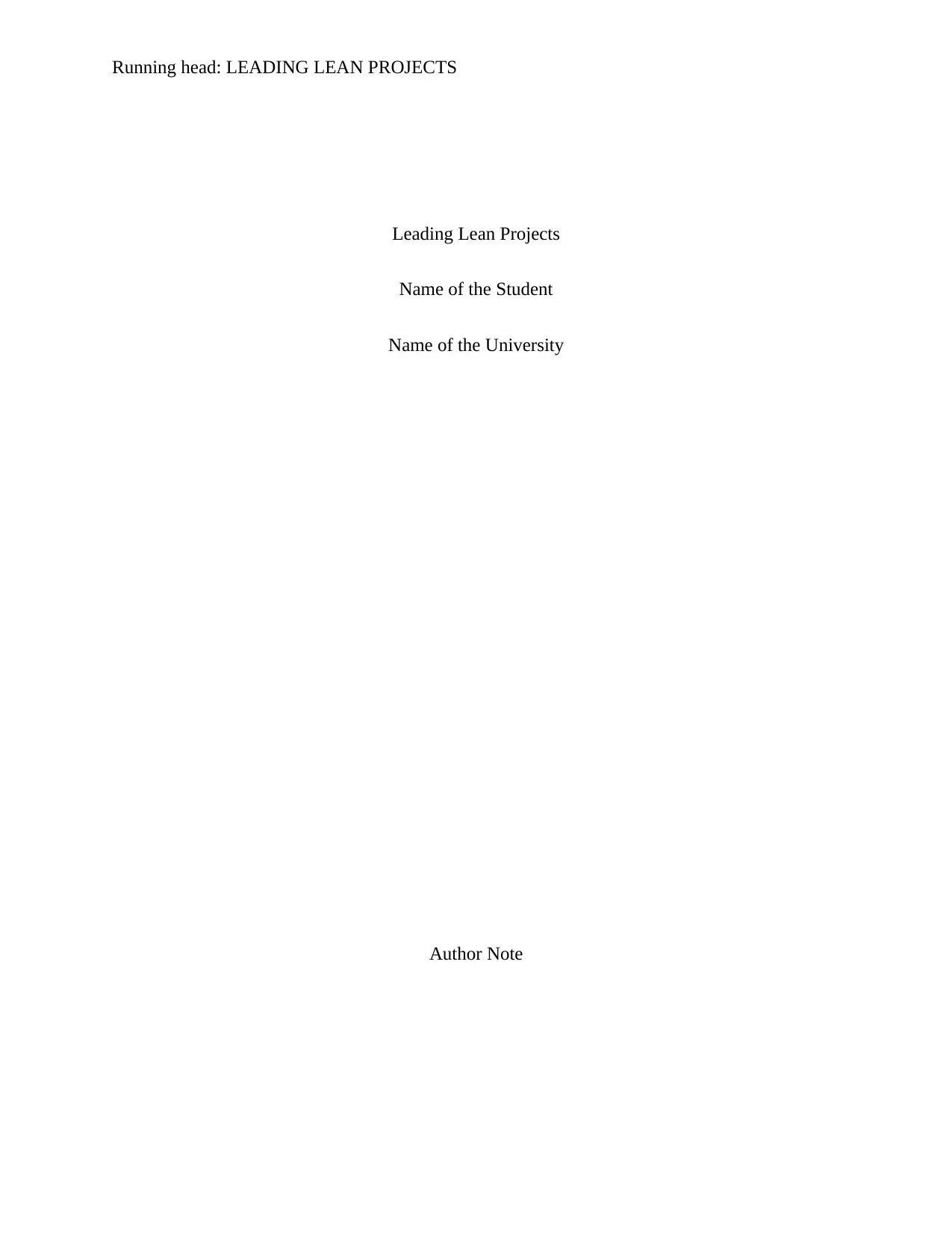
Running head: LEADING LEAN PROJECTS
Leading Lean Projects
Name of the Student
Name of the University
Author Note
Leading Lean Projects
Name of the Student
Name of the University
Author Note
Paraphrase This Document
Need a fresh take? Get an instant paraphrase of this document with our AI Paraphraser
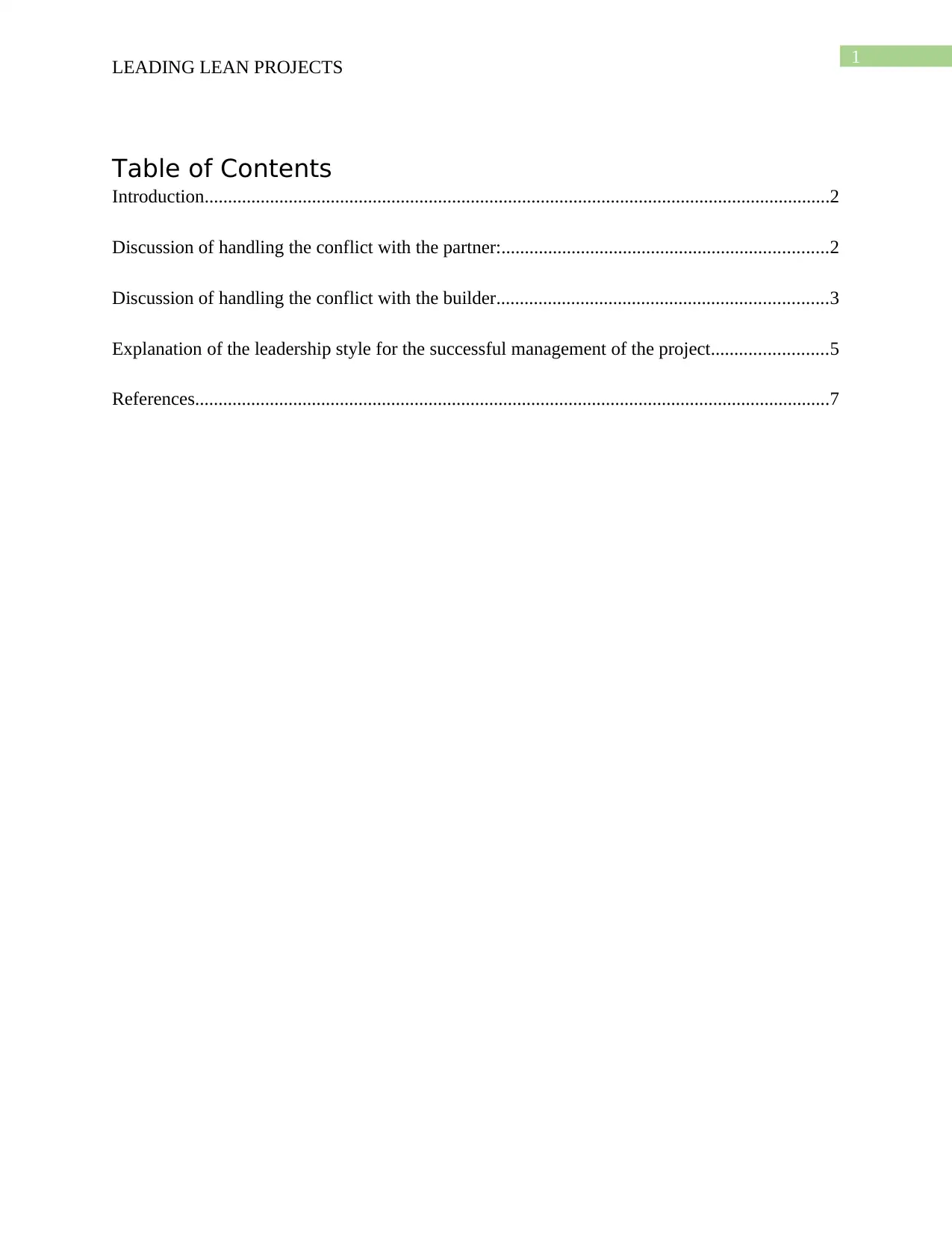
1
LEADING LEAN PROJECTS
Table of Contents
Introduction......................................................................................................................................2
Discussion of handling the conflict with the partner:......................................................................2
Discussion of handling the conflict with the builder.......................................................................3
Explanation of the leadership style for the successful management of the project.........................5
References........................................................................................................................................7
LEADING LEAN PROJECTS
Table of Contents
Introduction......................................................................................................................................2
Discussion of handling the conflict with the partner:......................................................................2
Discussion of handling the conflict with the builder.......................................................................3
Explanation of the leadership style for the successful management of the project.........................5
References........................................................................................................................................7
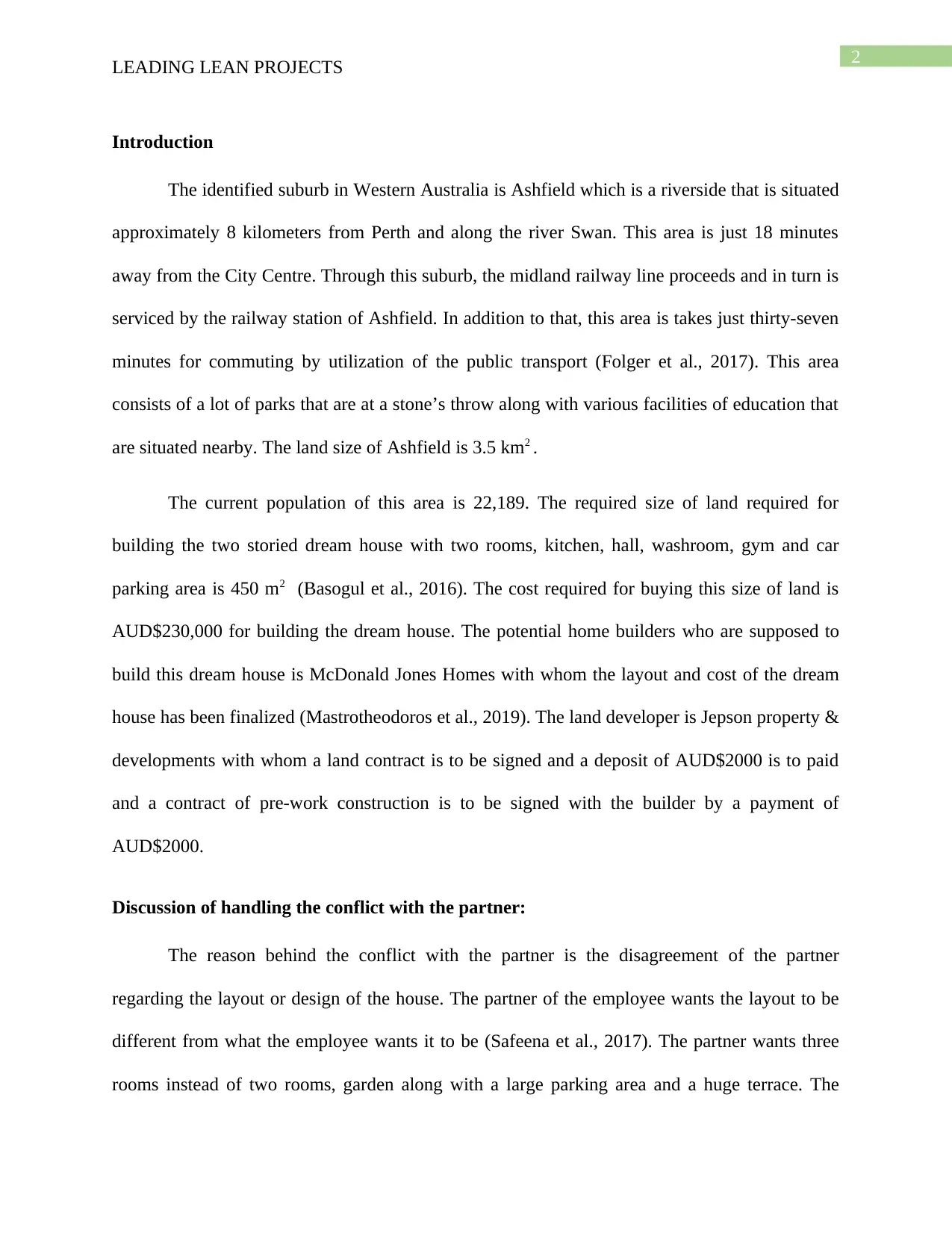
2
LEADING LEAN PROJECTS
Introduction
The identified suburb in Western Australia is Ashfield which is a riverside that is situated
approximately 8 kilometers from Perth and along the river Swan. This area is just 18 minutes
away from the City Centre. Through this suburb, the midland railway line proceeds and in turn is
serviced by the railway station of Ashfield. In addition to that, this area is takes just thirty-seven
minutes for commuting by utilization of the public transport (Folger et al., 2017). This area
consists of a lot of parks that are at a stone’s throw along with various facilities of education that
are situated nearby. The land size of Ashfield is 3.5 km2 .
The current population of this area is 22,189. The required size of land required for
building the two storied dream house with two rooms, kitchen, hall, washroom, gym and car
parking area is 450 m2 (Basogul et al., 2016). The cost required for buying this size of land is
AUD$230,000 for building the dream house. The potential home builders who are supposed to
build this dream house is McDonald Jones Homes with whom the layout and cost of the dream
house has been finalized (Mastrotheodoros et al., 2019). The land developer is Jepson property &
developments with whom a land contract is to be signed and a deposit of AUD$2000 is to paid
and a contract of pre-work construction is to be signed with the builder by a payment of
AUD$2000.
Discussion of handling the conflict with the partner:
The reason behind the conflict with the partner is the disagreement of the partner
regarding the layout or design of the house. The partner of the employee wants the layout to be
different from what the employee wants it to be (Safeena et al., 2017). The partner wants three
rooms instead of two rooms, garden along with a large parking area and a huge terrace. The
LEADING LEAN PROJECTS
Introduction
The identified suburb in Western Australia is Ashfield which is a riverside that is situated
approximately 8 kilometers from Perth and along the river Swan. This area is just 18 minutes
away from the City Centre. Through this suburb, the midland railway line proceeds and in turn is
serviced by the railway station of Ashfield. In addition to that, this area is takes just thirty-seven
minutes for commuting by utilization of the public transport (Folger et al., 2017). This area
consists of a lot of parks that are at a stone’s throw along with various facilities of education that
are situated nearby. The land size of Ashfield is 3.5 km2 .
The current population of this area is 22,189. The required size of land required for
building the two storied dream house with two rooms, kitchen, hall, washroom, gym and car
parking area is 450 m2 (Basogul et al., 2016). The cost required for buying this size of land is
AUD$230,000 for building the dream house. The potential home builders who are supposed to
build this dream house is McDonald Jones Homes with whom the layout and cost of the dream
house has been finalized (Mastrotheodoros et al., 2019). The land developer is Jepson property &
developments with whom a land contract is to be signed and a deposit of AUD$2000 is to paid
and a contract of pre-work construction is to be signed with the builder by a payment of
AUD$2000.
Discussion of handling the conflict with the partner:
The reason behind the conflict with the partner is the disagreement of the partner
regarding the layout or design of the house. The partner of the employee wants the layout to be
different from what the employee wants it to be (Safeena et al., 2017). The partner wants three
rooms instead of two rooms, garden along with a large parking area and a huge terrace. The
⊘ This is a preview!⊘
Do you want full access?
Subscribe today to unlock all pages.

Trusted by 1+ million students worldwide
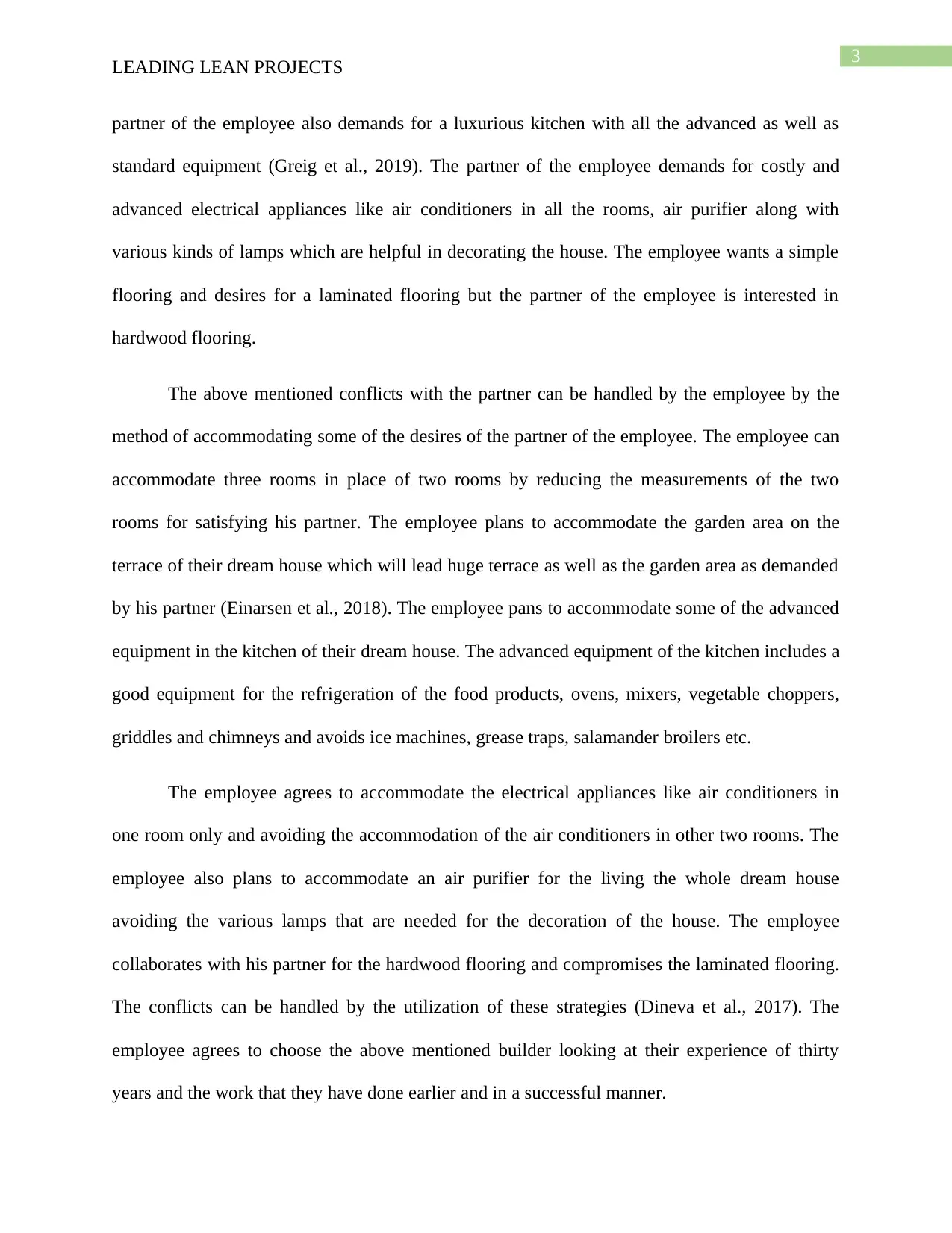
3
LEADING LEAN PROJECTS
partner of the employee also demands for a luxurious kitchen with all the advanced as well as
standard equipment (Greig et al., 2019). The partner of the employee demands for costly and
advanced electrical appliances like air conditioners in all the rooms, air purifier along with
various kinds of lamps which are helpful in decorating the house. The employee wants a simple
flooring and desires for a laminated flooring but the partner of the employee is interested in
hardwood flooring.
The above mentioned conflicts with the partner can be handled by the employee by the
method of accommodating some of the desires of the partner of the employee. The employee can
accommodate three rooms in place of two rooms by reducing the measurements of the two
rooms for satisfying his partner. The employee plans to accommodate the garden area on the
terrace of their dream house which will lead huge terrace as well as the garden area as demanded
by his partner (Einarsen et al., 2018). The employee pans to accommodate some of the advanced
equipment in the kitchen of their dream house. The advanced equipment of the kitchen includes a
good equipment for the refrigeration of the food products, ovens, mixers, vegetable choppers,
griddles and chimneys and avoids ice machines, grease traps, salamander broilers etc.
The employee agrees to accommodate the electrical appliances like air conditioners in
one room only and avoiding the accommodation of the air conditioners in other two rooms. The
employee also plans to accommodate an air purifier for the living the whole dream house
avoiding the various lamps that are needed for the decoration of the house. The employee
collaborates with his partner for the hardwood flooring and compromises the laminated flooring.
The conflicts can be handled by the utilization of these strategies (Dineva et al., 2017). The
employee agrees to choose the above mentioned builder looking at their experience of thirty
years and the work that they have done earlier and in a successful manner.
LEADING LEAN PROJECTS
partner of the employee also demands for a luxurious kitchen with all the advanced as well as
standard equipment (Greig et al., 2019). The partner of the employee demands for costly and
advanced electrical appliances like air conditioners in all the rooms, air purifier along with
various kinds of lamps which are helpful in decorating the house. The employee wants a simple
flooring and desires for a laminated flooring but the partner of the employee is interested in
hardwood flooring.
The above mentioned conflicts with the partner can be handled by the employee by the
method of accommodating some of the desires of the partner of the employee. The employee can
accommodate three rooms in place of two rooms by reducing the measurements of the two
rooms for satisfying his partner. The employee plans to accommodate the garden area on the
terrace of their dream house which will lead huge terrace as well as the garden area as demanded
by his partner (Einarsen et al., 2018). The employee pans to accommodate some of the advanced
equipment in the kitchen of their dream house. The advanced equipment of the kitchen includes a
good equipment for the refrigeration of the food products, ovens, mixers, vegetable choppers,
griddles and chimneys and avoids ice machines, grease traps, salamander broilers etc.
The employee agrees to accommodate the electrical appliances like air conditioners in
one room only and avoiding the accommodation of the air conditioners in other two rooms. The
employee also plans to accommodate an air purifier for the living the whole dream house
avoiding the various lamps that are needed for the decoration of the house. The employee
collaborates with his partner for the hardwood flooring and compromises the laminated flooring.
The conflicts can be handled by the utilization of these strategies (Dineva et al., 2017). The
employee agrees to choose the above mentioned builder looking at their experience of thirty
years and the work that they have done earlier and in a successful manner.
Paraphrase This Document
Need a fresh take? Get an instant paraphrase of this document with our AI Paraphraser
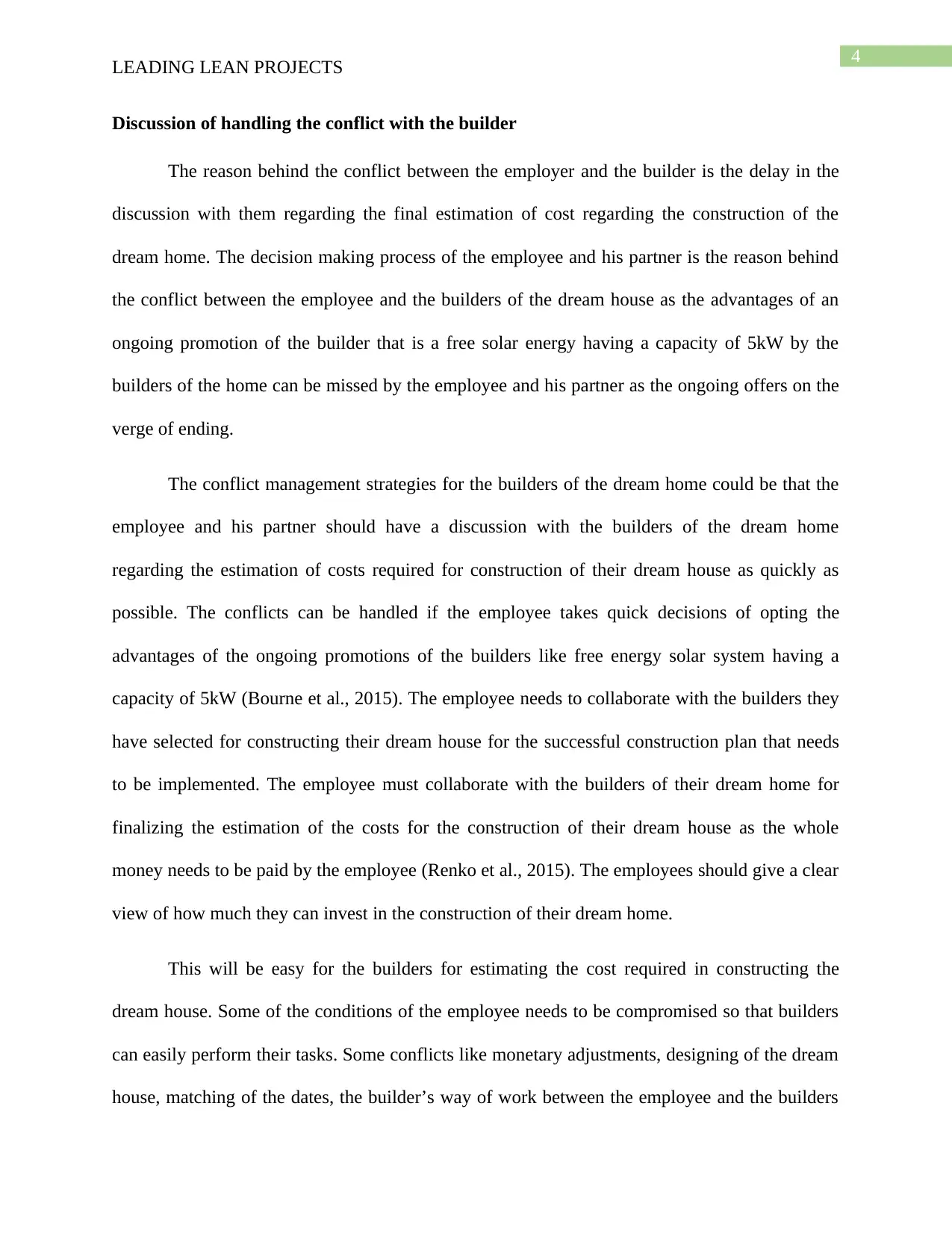
4
LEADING LEAN PROJECTS
Discussion of handling the conflict with the builder
The reason behind the conflict between the employer and the builder is the delay in the
discussion with them regarding the final estimation of cost regarding the construction of the
dream home. The decision making process of the employee and his partner is the reason behind
the conflict between the employee and the builders of the dream house as the advantages of an
ongoing promotion of the builder that is a free solar energy having a capacity of 5kW by the
builders of the home can be missed by the employee and his partner as the ongoing offers on the
verge of ending.
The conflict management strategies for the builders of the dream home could be that the
employee and his partner should have a discussion with the builders of the dream home
regarding the estimation of costs required for construction of their dream house as quickly as
possible. The conflicts can be handled if the employee takes quick decisions of opting the
advantages of the ongoing promotions of the builders like free energy solar system having a
capacity of 5kW (Bourne et al., 2015). The employee needs to collaborate with the builders they
have selected for constructing their dream house for the successful construction plan that needs
to be implemented. The employee must collaborate with the builders of their dream home for
finalizing the estimation of the costs for the construction of their dream house as the whole
money needs to be paid by the employee (Renko et al., 2015). The employees should give a clear
view of how much they can invest in the construction of their dream home.
This will be easy for the builders for estimating the cost required in constructing the
dream house. Some of the conditions of the employee needs to be compromised so that builders
can easily perform their tasks. Some conflicts like monetary adjustments, designing of the dream
house, matching of the dates, the builder’s way of work between the employee and the builders
LEADING LEAN PROJECTS
Discussion of handling the conflict with the builder
The reason behind the conflict between the employer and the builder is the delay in the
discussion with them regarding the final estimation of cost regarding the construction of the
dream home. The decision making process of the employee and his partner is the reason behind
the conflict between the employee and the builders of the dream house as the advantages of an
ongoing promotion of the builder that is a free solar energy having a capacity of 5kW by the
builders of the home can be missed by the employee and his partner as the ongoing offers on the
verge of ending.
The conflict management strategies for the builders of the dream home could be that the
employee and his partner should have a discussion with the builders of the dream home
regarding the estimation of costs required for construction of their dream house as quickly as
possible. The conflicts can be handled if the employee takes quick decisions of opting the
advantages of the ongoing promotions of the builders like free energy solar system having a
capacity of 5kW (Bourne et al., 2015). The employee needs to collaborate with the builders they
have selected for constructing their dream house for the successful construction plan that needs
to be implemented. The employee must collaborate with the builders of their dream home for
finalizing the estimation of the costs for the construction of their dream house as the whole
money needs to be paid by the employee (Renko et al., 2015). The employees should give a clear
view of how much they can invest in the construction of their dream home.
This will be easy for the builders for estimating the cost required in constructing the
dream house. Some of the conditions of the employee needs to be compromised so that builders
can easily perform their tasks. Some conflicts like monetary adjustments, designing of the dream
house, matching of the dates, the builder’s way of work between the employee and the builders
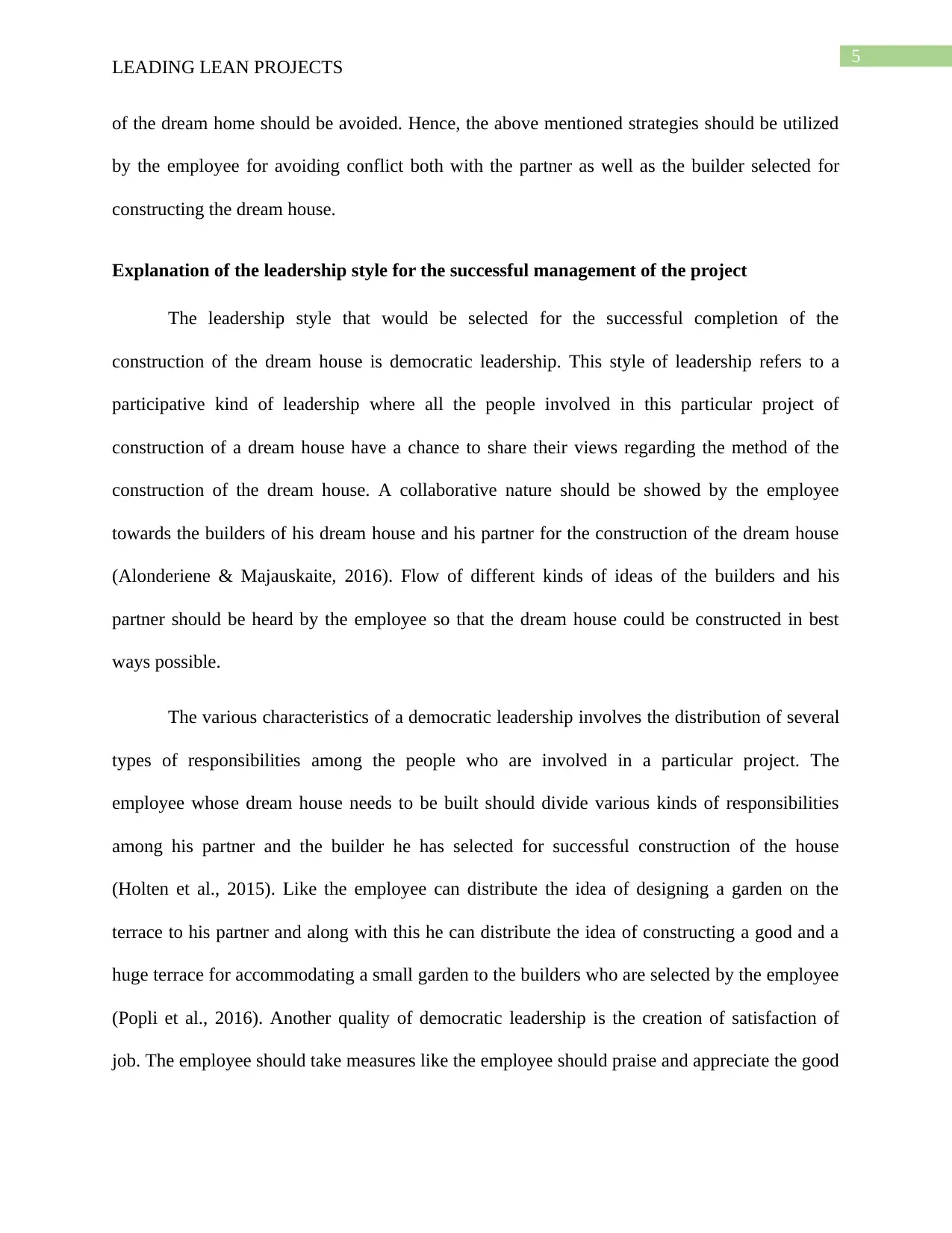
5
LEADING LEAN PROJECTS
of the dream home should be avoided. Hence, the above mentioned strategies should be utilized
by the employee for avoiding conflict both with the partner as well as the builder selected for
constructing the dream house.
Explanation of the leadership style for the successful management of the project
The leadership style that would be selected for the successful completion of the
construction of the dream house is democratic leadership. This style of leadership refers to a
participative kind of leadership where all the people involved in this particular project of
construction of a dream house have a chance to share their views regarding the method of the
construction of the dream house. A collaborative nature should be showed by the employee
towards the builders of his dream house and his partner for the construction of the dream house
(Alonderiene & Majauskaite, 2016). Flow of different kinds of ideas of the builders and his
partner should be heard by the employee so that the dream house could be constructed in best
ways possible.
The various characteristics of a democratic leadership involves the distribution of several
types of responsibilities among the people who are involved in a particular project. The
employee whose dream house needs to be built should divide various kinds of responsibilities
among his partner and the builder he has selected for successful construction of the house
(Holten et al., 2015). Like the employee can distribute the idea of designing a garden on the
terrace to his partner and along with this he can distribute the idea of constructing a good and a
huge terrace for accommodating a small garden to the builders who are selected by the employee
(Popli et al., 2016). Another quality of democratic leadership is the creation of satisfaction of
job. The employee should take measures like the employee should praise and appreciate the good
LEADING LEAN PROJECTS
of the dream home should be avoided. Hence, the above mentioned strategies should be utilized
by the employee for avoiding conflict both with the partner as well as the builder selected for
constructing the dream house.
Explanation of the leadership style for the successful management of the project
The leadership style that would be selected for the successful completion of the
construction of the dream house is democratic leadership. This style of leadership refers to a
participative kind of leadership where all the people involved in this particular project of
construction of a dream house have a chance to share their views regarding the method of the
construction of the dream house. A collaborative nature should be showed by the employee
towards the builders of his dream house and his partner for the construction of the dream house
(Alonderiene & Majauskaite, 2016). Flow of different kinds of ideas of the builders and his
partner should be heard by the employee so that the dream house could be constructed in best
ways possible.
The various characteristics of a democratic leadership involves the distribution of several
types of responsibilities among the people who are involved in a particular project. The
employee whose dream house needs to be built should divide various kinds of responsibilities
among his partner and the builder he has selected for successful construction of the house
(Holten et al., 2015). Like the employee can distribute the idea of designing a garden on the
terrace to his partner and along with this he can distribute the idea of constructing a good and a
huge terrace for accommodating a small garden to the builders who are selected by the employee
(Popli et al., 2016). Another quality of democratic leadership is the creation of satisfaction of
job. The employee should take measures like the employee should praise and appreciate the good
⊘ This is a preview!⊘
Do you want full access?
Subscribe today to unlock all pages.

Trusted by 1+ million students worldwide
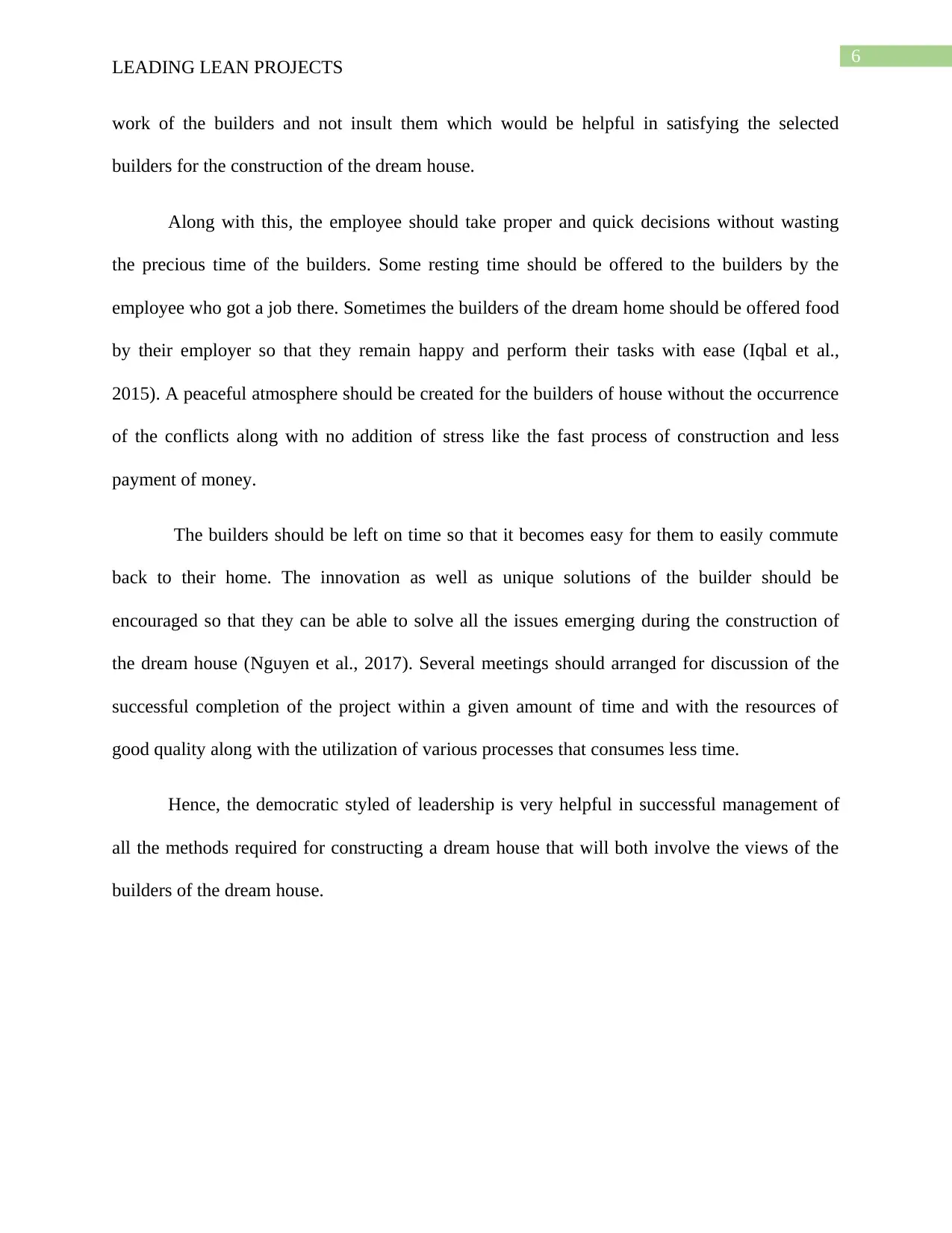
6
LEADING LEAN PROJECTS
work of the builders and not insult them which would be helpful in satisfying the selected
builders for the construction of the dream house.
Along with this, the employee should take proper and quick decisions without wasting
the precious time of the builders. Some resting time should be offered to the builders by the
employee who got a job there. Sometimes the builders of the dream home should be offered food
by their employer so that they remain happy and perform their tasks with ease (Iqbal et al.,
2015). A peaceful atmosphere should be created for the builders of house without the occurrence
of the conflicts along with no addition of stress like the fast process of construction and less
payment of money.
The builders should be left on time so that it becomes easy for them to easily commute
back to their home. The innovation as well as unique solutions of the builder should be
encouraged so that they can be able to solve all the issues emerging during the construction of
the dream house (Nguyen et al., 2017). Several meetings should arranged for discussion of the
successful completion of the project within a given amount of time and with the resources of
good quality along with the utilization of various processes that consumes less time.
Hence, the democratic styled of leadership is very helpful in successful management of
all the methods required for constructing a dream house that will both involve the views of the
builders of the dream house.
LEADING LEAN PROJECTS
work of the builders and not insult them which would be helpful in satisfying the selected
builders for the construction of the dream house.
Along with this, the employee should take proper and quick decisions without wasting
the precious time of the builders. Some resting time should be offered to the builders by the
employee who got a job there. Sometimes the builders of the dream home should be offered food
by their employer so that they remain happy and perform their tasks with ease (Iqbal et al.,
2015). A peaceful atmosphere should be created for the builders of house without the occurrence
of the conflicts along with no addition of stress like the fast process of construction and less
payment of money.
The builders should be left on time so that it becomes easy for them to easily commute
back to their home. The innovation as well as unique solutions of the builder should be
encouraged so that they can be able to solve all the issues emerging during the construction of
the dream house (Nguyen et al., 2017). Several meetings should arranged for discussion of the
successful completion of the project within a given amount of time and with the resources of
good quality along with the utilization of various processes that consumes less time.
Hence, the democratic styled of leadership is very helpful in successful management of
all the methods required for constructing a dream house that will both involve the views of the
builders of the dream house.
Paraphrase This Document
Need a fresh take? Get an instant paraphrase of this document with our AI Paraphraser
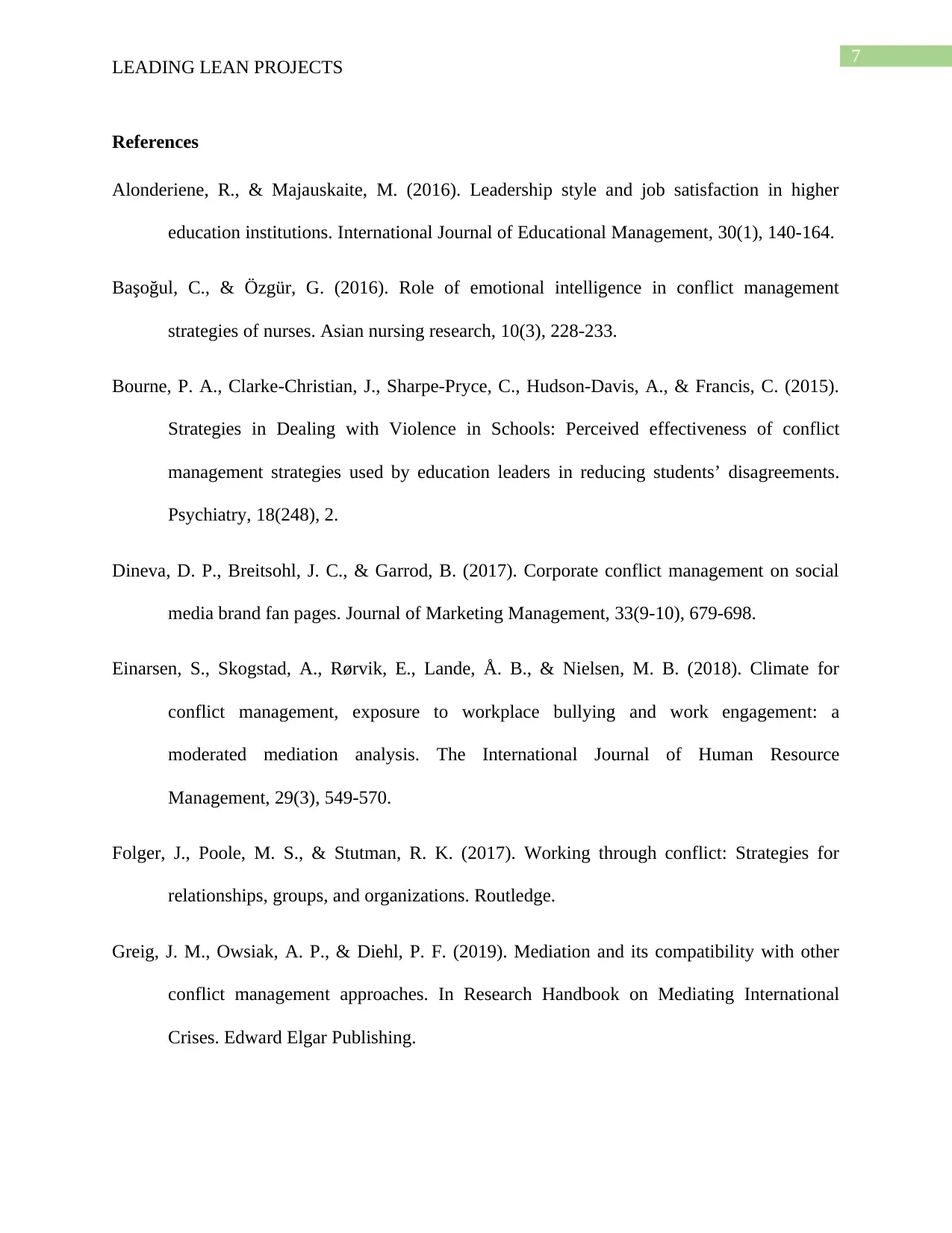
7
LEADING LEAN PROJECTS
References
Alonderiene, R., & Majauskaite, M. (2016). Leadership style and job satisfaction in higher
education institutions. International Journal of Educational Management, 30(1), 140-164.
Başoğul, C., & Özgür, G. (2016). Role of emotional intelligence in conflict management
strategies of nurses. Asian nursing research, 10(3), 228-233.
Bourne, P. A., Clarke-Christian, J., Sharpe-Pryce, C., Hudson-Davis, A., & Francis, C. (2015).
Strategies in Dealing with Violence in Schools: Perceived effectiveness of conflict
management strategies used by education leaders in reducing students’ disagreements.
Psychiatry, 18(248), 2.
Dineva, D. P., Breitsohl, J. C., & Garrod, B. (2017). Corporate conflict management on social
media brand fan pages. Journal of Marketing Management, 33(9-10), 679-698.
Einarsen, S., Skogstad, A., Rørvik, E., Lande, Å. B., & Nielsen, M. B. (2018). Climate for
conflict management, exposure to workplace bullying and work engagement: a
moderated mediation analysis. The International Journal of Human Resource
Management, 29(3), 549-570.
Folger, J., Poole, M. S., & Stutman, R. K. (2017). Working through conflict: Strategies for
relationships, groups, and organizations. Routledge.
Greig, J. M., Owsiak, A. P., & Diehl, P. F. (2019). Mediation and its compatibility with other
conflict management approaches. In Research Handbook on Mediating International
Crises. Edward Elgar Publishing.
LEADING LEAN PROJECTS
References
Alonderiene, R., & Majauskaite, M. (2016). Leadership style and job satisfaction in higher
education institutions. International Journal of Educational Management, 30(1), 140-164.
Başoğul, C., & Özgür, G. (2016). Role of emotional intelligence in conflict management
strategies of nurses. Asian nursing research, 10(3), 228-233.
Bourne, P. A., Clarke-Christian, J., Sharpe-Pryce, C., Hudson-Davis, A., & Francis, C. (2015).
Strategies in Dealing with Violence in Schools: Perceived effectiveness of conflict
management strategies used by education leaders in reducing students’ disagreements.
Psychiatry, 18(248), 2.
Dineva, D. P., Breitsohl, J. C., & Garrod, B. (2017). Corporate conflict management on social
media brand fan pages. Journal of Marketing Management, 33(9-10), 679-698.
Einarsen, S., Skogstad, A., Rørvik, E., Lande, Å. B., & Nielsen, M. B. (2018). Climate for
conflict management, exposure to workplace bullying and work engagement: a
moderated mediation analysis. The International Journal of Human Resource
Management, 29(3), 549-570.
Folger, J., Poole, M. S., & Stutman, R. K. (2017). Working through conflict: Strategies for
relationships, groups, and organizations. Routledge.
Greig, J. M., Owsiak, A. P., & Diehl, P. F. (2019). Mediation and its compatibility with other
conflict management approaches. In Research Handbook on Mediating International
Crises. Edward Elgar Publishing.
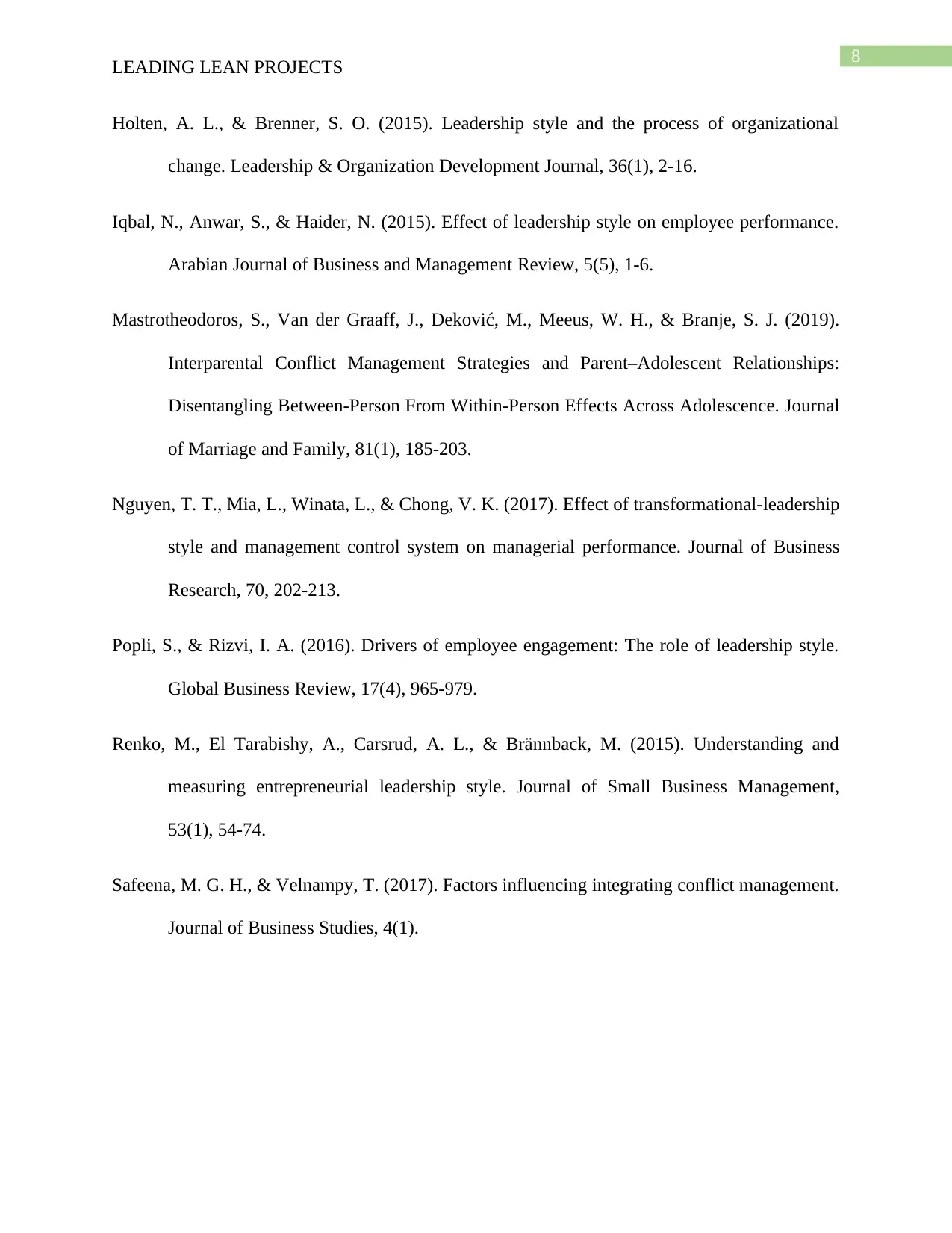
8
LEADING LEAN PROJECTS
Holten, A. L., & Brenner, S. O. (2015). Leadership style and the process of organizational
change. Leadership & Organization Development Journal, 36(1), 2-16.
Iqbal, N., Anwar, S., & Haider, N. (2015). Effect of leadership style on employee performance.
Arabian Journal of Business and Management Review, 5(5), 1-6.
Mastrotheodoros, S., Van der Graaff, J., Deković, M., Meeus, W. H., & Branje, S. J. (2019).
Interparental Conflict Management Strategies and Parent–Adolescent Relationships:
Disentangling Between‐Person From Within‐Person Effects Across Adolescence. Journal
of Marriage and Family, 81(1), 185-203.
Nguyen, T. T., Mia, L., Winata, L., & Chong, V. K. (2017). Effect of transformational-leadership
style and management control system on managerial performance. Journal of Business
Research, 70, 202-213.
Popli, S., & Rizvi, I. A. (2016). Drivers of employee engagement: The role of leadership style.
Global Business Review, 17(4), 965-979.
Renko, M., El Tarabishy, A., Carsrud, A. L., & Brännback, M. (2015). Understanding and
measuring entrepreneurial leadership style. Journal of Small Business Management,
53(1), 54-74.
Safeena, M. G. H., & Velnampy, T. (2017). Factors influencing integrating conflict management.
Journal of Business Studies, 4(1).
LEADING LEAN PROJECTS
Holten, A. L., & Brenner, S. O. (2015). Leadership style and the process of organizational
change. Leadership & Organization Development Journal, 36(1), 2-16.
Iqbal, N., Anwar, S., & Haider, N. (2015). Effect of leadership style on employee performance.
Arabian Journal of Business and Management Review, 5(5), 1-6.
Mastrotheodoros, S., Van der Graaff, J., Deković, M., Meeus, W. H., & Branje, S. J. (2019).
Interparental Conflict Management Strategies and Parent–Adolescent Relationships:
Disentangling Between‐Person From Within‐Person Effects Across Adolescence. Journal
of Marriage and Family, 81(1), 185-203.
Nguyen, T. T., Mia, L., Winata, L., & Chong, V. K. (2017). Effect of transformational-leadership
style and management control system on managerial performance. Journal of Business
Research, 70, 202-213.
Popli, S., & Rizvi, I. A. (2016). Drivers of employee engagement: The role of leadership style.
Global Business Review, 17(4), 965-979.
Renko, M., El Tarabishy, A., Carsrud, A. L., & Brännback, M. (2015). Understanding and
measuring entrepreneurial leadership style. Journal of Small Business Management,
53(1), 54-74.
Safeena, M. G. H., & Velnampy, T. (2017). Factors influencing integrating conflict management.
Journal of Business Studies, 4(1).
⊘ This is a preview!⊘
Do you want full access?
Subscribe today to unlock all pages.

Trusted by 1+ million students worldwide
1 out of 9
Related Documents
Your All-in-One AI-Powered Toolkit for Academic Success.
+13062052269
info@desklib.com
Available 24*7 on WhatsApp / Email
![[object Object]](/_next/static/media/star-bottom.7253800d.svg)
Unlock your academic potential
Copyright © 2020–2025 A2Z Services. All Rights Reserved. Developed and managed by ZUCOL.





